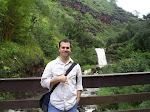
Kia ora, tatou...
At long last, another post. I wish I could give you some intricate, amazing reason, fantastical in origin, to explain my long absence from this site. Alas, I cannot. However, I can say that I have been back to the States once and headlong into fieldwork.
It is hard to believe that over 1 year has past since I and my family came to NZ. The research is well underway, with nine months officially completed. The first six of those months have been focused towards getting my feet wet in the project- helping out on a pest eradication volunteer team almost on a daily basis, with the odd plant pest removal team task, and all sorts of various tasks connected to the Maungatautari project. All along the way, I have attended Trust board meetings, getting to know the many people united by the project.
More recently, I have shifted to working more in the business office of the project, which at present, and over the last year, has been staffed primarily by volunteers. In this position, I have been able to attend more meetings and become connected to other volunteer teams in the project: planting teams, mountain guide teams, the education committee and the meet and greet team- all aspects of the project with many volunteers for me to meet and interview while working alongside them. It has been fun to meet each and every one and learn what they do- how they contribute to the project.
As for me and my family- it has been a rocky few months. My wife's mother had been very sick and recently passed away. My wife went to the US to see her before the expected descent into her final weeks to spend time with her. Then a few weeks later, we all went to the US to see her right before the end, surprising my family in the process- my family only expected my wife, and two of our children to arrive. We had them enter my parent's home, and get to talking, while I and my remaining kids arrived at the front door and waited outside- we then rang the doorbell and had their grandchildren jump at them when they opened the door. Priceless.
Having returned home, the kids got back into school- and they are doing well. Juliana is excelling at cross-country running despite being the shortest in height of her peers, and Mele has taken some awards in jump roping and reading improvement (which is significant as she went into a higher school grade coming into the NZ school year halfway). The winter weather though as been atrocious- tons more rain than last year, though not as cold. But, spring is now upon us, despite a last ditch effort by old man winter to torment us- a week-long storm hit NZ from the west, which was larger than the whole of Australia. Power went out in many places across the country, hail, tornadoes, severe storm damage, floods all took their toll- but here in the Waikato region, we were spared the brunt of it.
However, the storm was poorly timed- Canturbury/Christchurch area of the South Island was already dealing with the severe damage caused by a 7+ earthquake- many people cannot go back to their homes and jobs. Then along comes this storm. On the news it was heartening to see the by-in-large positive response most people were exhibiting to the daily challenges associated with just getting water to drink and food to eat. it reminds me that we should all be prepared - and especially with 72 hours kits.
What I am not enjoying about the research at the moment is the distraction of finding research funds. While my family and I could not be here without the scholarship I won, the cost of living here has gone up and we cannot float costs personally any more, thus I am looking for funding from within and without NZ. There are a few potential sources, but the timing of any funds, if awarded, can be far off. Keep fingers crossed. Other than this, and the research is great- I have had many informal interviews with people and been able to observe and be a part of many meetings within the Trust. On the horizon is recorded semi-formal interviews and the construction/development of a freelist questionaire.
Haere Ra,
Matt Harms











